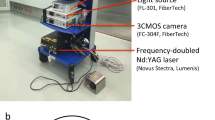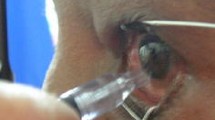Summary
To assess the clinical effectiveness of glaucoma therapy with diode laser cyclophotocoagulation, 106 eyes (51 eyes with primary open-angle glaucoma, 22 eyes with secondary glaucoma, 10 eyes with narrow-angle glaucoma, 23 eyes with other glaucomas) of 87 patients were treated. Using a diode laser coupled with a fiberoptic probe, ending in a focusing tip, all eyes were treated with 24–30 spots over 360 ° and 2.8–3.6 J of energy, 1.5 mm posterior to the limbus. The intraocular pressure was obtained over a period of time until 8–24 months after operation. Additionally, morphological changes of the ciliary body were observed in 25 eyes by means of ultrasound biomicroscopy.
Results: The IOP decreased from a baseline mean of 25.0 ± 5.7 mm Hg to 17.6 ± 5.3 mm Hg directly after operation and increased sligthly to 18.0 ± 6.0 mm Hg in the following 24 months. Successful control of IOP (IOP constantly < 22 mm Hg or pain relief in blind eyes) occurred in 90 of 106 eyes (84.9 %). In 23 eyes more than one treatment was given. In 6 eyes another IOP-reducing operation had to be performed. In 19 eyes slightly elongated intraocular inflammatory reactions were seen, without any serious complications. The morphological investigations showed in 22 of 25 cases temporary edema of the ciliary body. A temporary detachment of the ciliary body was seen in 8 eyes.
Conclusions: Diode laser cyclophotocoagulation is an effective and safe procedure to reduce IOP in different types of glaucoma over a long time. Postoperatively, a temporary inflammatory reaction of the ciliary body was observed with no correlation to the degree of reduction of the IOP.
Zusammenfassung
Um die therapeutische Effektivität der Glaukomtherapie mittels Diodenlaserzyklophotokoagulation zu evaluieren, wurden die intraokularen Tensionswerte (IOP) nach Zyklophotokoagulation an 106 Augen 8–24 Monate postoperativ erfaßt.
Methode: 24–30 Laserherde mit einer Energie von 2,8–3,6 J wurden mittels Fokussieroptik 1,5 mm hinter dem Limbus zirkulär über 360 ° gesetzt. 25 der operierten Augen wurden postoperativ ultraschallbiomikroskopisch auf Ziliarkörperveränderungen untersucht.
Ergebnisse: Der mittlere IOP sank von präoperativ 25,0 ± 5,7 mm Hg auf 18,0 ± 6,0 mm Hg langfristig postoperativ. Eine erfolgreiche Tensionsregelung (IOP < 22 mm Hg bzw. dauerhafte Schmerzfreiheit bei funktionslosen Augen) wurde bei 85 % der Augen erreicht, wobei bei 23 Augen mehr als 1 Zyklophotokoagulation durchgeführt werden mußte und 6 Augen wegen der Notwendigkeit einer anderen tensionsregulierenden Operation aus der Studie ausschieden. Es traten keine schwerwiegenden Komplikationen auf. Die morphologischen Untersuchungen zeigten bei 22 von 25 Augen eine temporäre postoperative Ziliarkörperschwellung und bei 8 Augen eine temporäre Ziliarkörperabhebung.
Schlußfolgerung: Die Zyklophotokoagulation mit dem Diodenlaser führt bei verschiedenen Glaukomarten risikoarm auch langfristig zu einer effektiven IOP-Senkung. Morphologisch zeigt sich postoperativ eine entzündliche Reaktion im Ziliarkörper, deren Ausmaß nicht mit der Höhe der Tensionssenkung korreliert.
Similar content being viewed by others
Author information
Authors and Affiliations
Rights and permissions
About this article
Cite this article
Werner, A., Vick, HP. & Guthoff, R. Results of glaucoma therapy with diode laser cyclophotocoagulation. Ophthalmologe 95, 176–180 (1998). https://doi.org/10.1007/s003470050259
Published:
Issue Date:
DOI: https://doi.org/10.1007/s003470050259




